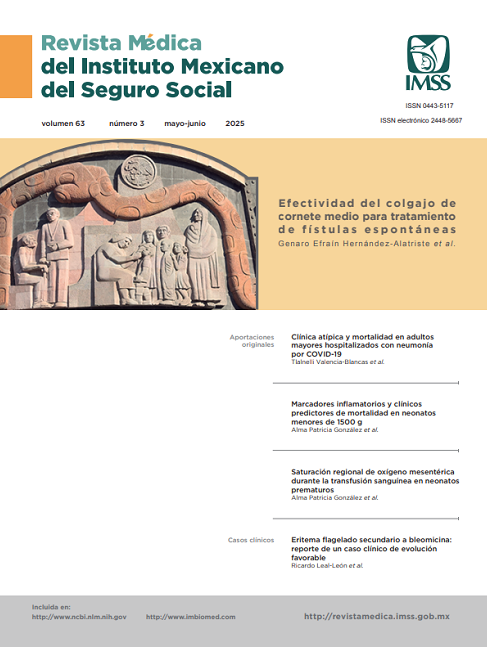Effectiveness of the middle turbinate flap for the treatment of spontaneous fistulas
Main Article Content
Keywords
Fistula, Cerebrospinal Fluid, Middle Turbinate, Skull Base
Abstract
Background: Currently there is no certainty on which is the best treatment for spontaneous cerebrospinal fluid (CSF) fistulas. This study aimed to test the effectiveness of the pedicled middle turbinate flap (PMTF) in the treatment of said fistulas, located in the anterior skull base floor (ASBF).
Objective: To demonstrate the reduction in recurrence of spontaneous CSF fistulas in the ASBF treated with endoscopic endonasal PMTF.
Material and methods: Ambispective cohort study which included patients with spontaneous CSF fistulas located in the ASBF, treated with PMTF and nasoseptal flap (NSF) by endoscopic endonasal route in a third-level hospital from March 1, 2020, to February 28, 2023. 2 groups were compared: group A, for patients treated with PMTF, and group B, patients treated with NSF. It was calculated chi squared for recurrence, complications and surgical reintervention. A p value < 0.05 was considered significant.
Results: The total was of 13 patients. The most frequent cause was spontaneous (9 cases). PMTF was used in 7 cases and NSF in 6. In group A the recurrence was 42%, and in group B 66% (p = 0.38). Only 1 patient in group A underwent reoperation vs. 4 in group B (p = 0.05).
Conclusions: The use of PMTF has fewer cases of recurrence compared to NSF, even though it was not statistically significant. The statistical significance for reintervention in group A suggests that PMTF may be a viable option for these patients.
References
Alicandri-Ciufelli M, Fermi M, Rosa MS et al. Spontaneous nasal cerebrospinal fluid leak repaired with single-layer mucoperichondrial graft: Long-term results. Am J Rhinol Allergy. 2020;34(3):382-7. doi: 10.1177/1945892419900485
Allensworth JJ, Rowan NR, Storck KA et al. Endoscopic repair of spontaneous skull base defects decreases the incidence rate of intracranial complications. Int Forum Allergy Rhinol. 2019;9(10):1089-96. doi: 10.1002/alr.22399
Valencia-Sanchez BA, Zhou S, Patel VA et al. Pediatric Spontaneous Cerebrospinal fluid leak Repair: An Endoscopic endonasal approach. Ear Nose & Throat Journal. 2023;102(9_suppl):40S-42S. doi: 10.1177/01455613231184959
Hallak B, Kurzbuch AR, Fournier JY et al. Spontaneous transethmoidal meningoencephalocele presenting in the form of recurrent unilateral nasal discharge: discussion of the diagnosis and endoscopic surgical management. BMJ Case Rep. 2020;13(5):e234703. doi: 10.1136/bcr-2020-234703
Kim-Orden N, Shen J, Or M et al. Endoscopic endonasal repair of spontaneous cerebrospinal fluid leaks using multilayer composite graft and vascularized pedicled nasoseptal flap technique. Allergy Rhinol (Providence). 2019;10:215265671988862. doi: 10.1177/2152656719888622
Keshri A, Jain R, Manogaran RS et al. Management of spontaneous CSF rhinorrhea: An institutional experience. J Neurol Surg B Skull Base. 2019;80(05):493-9. doi: 10.1055/s-0038-1676334
Kreatsoulas DC, Shah VS, Otto BA et al. Surgical outcomes of the endonasal endoscopic approach within a standardized management protocol for repair of spontaneous cerebrospinal fluid rhinorrhea. J Neurosurg. 2021;134(3):780-6. doi: 10.3171/2019.12.jns192891
Hadad G, Bassagasteguy L, Carrau RL, et al. A novel reconstructive technique after endoscopic expanded endonasal approaches: vascular pedicle nasoseptal flap. The Laryngoscope. 2006;116(10):1882-6. doi: 10.1097/01.mlg.0000234933.37779.e4
Bubshait RF, Moumen AA. The Endonasal Endoscopic Management of Cerebrospinal Fluid Rhinorrhea. Cureus. 2021;13(2):e13457. doi: 10.7759/cureus.13457
Nix P, Tyagi A, Phillips N. Retrospective analysis of anterior skull base CSF leaks and endoscopic repairs at Leeds. Br J Neurosurg. 2016;30(4):422-6. doi: 10.3109/02688697.2016.1161176
Tan Y, Li J, Liu Y et al. Comparative analysis of transnasal endoscopic reconstruction techniques for managing cerebrospinal fluid rhinorrhea in skull base defects. Journal of Clinical Neuroscience. 2024;125:38-42. doi: 10.1016/j.jocn.2024.05.010
Manimaran V, Lakshmanan S, Prateep A, et al. Outcomes of middle turbinate flap in the reconstruction of non-tumorous ventral skull base defects - an institutional review. Turk Arch Otorhinolaryngol. 2021;58(4):214-9. doi: 10.5152/tao.2020.5743
Prevedello DM, Barges-Coll J, Fernandez-Miranda JC et al. Middle turbinate flap for skull base reconstruction: Cadaveric feasibility study. Laryngoscope. 2009;119(11):2094-8. doi: 10.1002/lary.20226
Carnevale C, Til-Pérez G, Tomás-Barberán M et al. Middle turbinate mucosal flap: Low‐morbidity option in the management of skull base defects. Head Neck. 2021;43(5):1415-20. doi: 10.1002/hed.26613
Galli J, Morelli F, Rigante M et al. Management of cerebrospinal fluid leak: the importance of multidisciplinary approach. Acta Otorhinolaryngol Ital. 2021;41(Suppl. 1):S18-29. doi: 10.14639/0392-100x-suppl.1-41-2021-02
Wolf A, Andrianakis A, Tomazic PV et al. Preservation of nasal turbinates in endoscopic, anterior skull base surgery—yes, we can! Eur Arch Otorhinolaryngol. 2022;279(2):785-91. doi: 10.1007/s00405-021-06856-9
Jolly K, Gupta KK, Banota A, et al. The effectiveness and safety of intrathecal fluorescein in the management of cerebrospinal fluid leaks. American Journal of Rhinology and Allergy. 2021;35(6):879-84. doi: 10.1177/19458924211020564
Carvalho ACM de, Dolci RLL, Rickli JCK et al. Evaluation of olfactory function in patients undergoing endoscopic skull base surgery with nasoseptal flap. Braz J Otorhinolaryngol. 2022;88(1):15-21. doi: 10.1016/j.bjorl.2020.03.006
Griffiths CF, Barkhoudarian G, Cutler A, et al. Analysis of Olfaction after Bilateral Nasoseptal Rescue Flap Transsphenoidal Approach with Olfactory Mucosal Preservation. Otolaryngology. 2019;161(5):881-9. doi: 10.1177/0194599819861340
Barke M, Castro HM, Adesina O, et al. Thinning of the skull base and calvarial thickness in patients with idiopathic intracranial hypertension. Journal of Neuro-Ophthalmology. 2022;42(2):192-8. doi: 10.1097/wno.0000000000001504
Takahara K, Ueda R, Toda M. Endoscopic endonasal reconstruction using a pedicled middle turbinate flap for spontaneous cerebrospinal fluid rhinorrhea. Journal of Craniofacial Surgery. 2021;33(3):e318–20. doi: 10.1097/scs.0000000000008214
Gutierrez WR, Bennion DM, Walsh JE et al. Vascular pedicled flaps for skull base defect reconstruction. Laryngoscope Investigative Otolaryngology. 2020;5(6):1029-38. doi: 10.1002/lio2.471
Zeiger J, Costa A, Bederson J, et al. Use of mixed reality visualization in endoscopic endonasal skull base surgery. Operative Neurosurgery. 2019;19(1):43-52. doi: 10.1093/ons/opz355
Xie M, Zhou K, Kachra S et al. Diagnosis and localization of Cerebrospinal fluid rhinorrhea: A systematic review. Am J Rhinol Allergy. 2022;36(3):397-406. doi: 10.1177/19458924211060918
Thompson HM, Schlosser RJ, Walsh EM, et al. Current management of congenital anterior cranial base encephaloceles. International Journal of Pediatric Otorhinolaryngology. 2020;131:109868. doi: 10.1016/j.ijporl.2020.109868
Abiri A, Abiri P, Goshtasbi K, et al. Endoscopic Anterior Skull Base Reconstruction: A Meta-Analysis and Systematic Review of Graft Type. World Neurosurgery. 2020;139:460-70. doi: 10.1016/j.wneu.2020.04.089
Michael AP, Elbuluk O, Tsiouris AJ, et al. The critical importance of a vascularized flap in preventing recurrence after endoscopic repair of spontaneous cerebrospinal fluid leaks and meningoencephaloceles. Journal of Neurosurgery. 2021;137(1):79-86. doi: 10.3171/2021.7.jns211427


